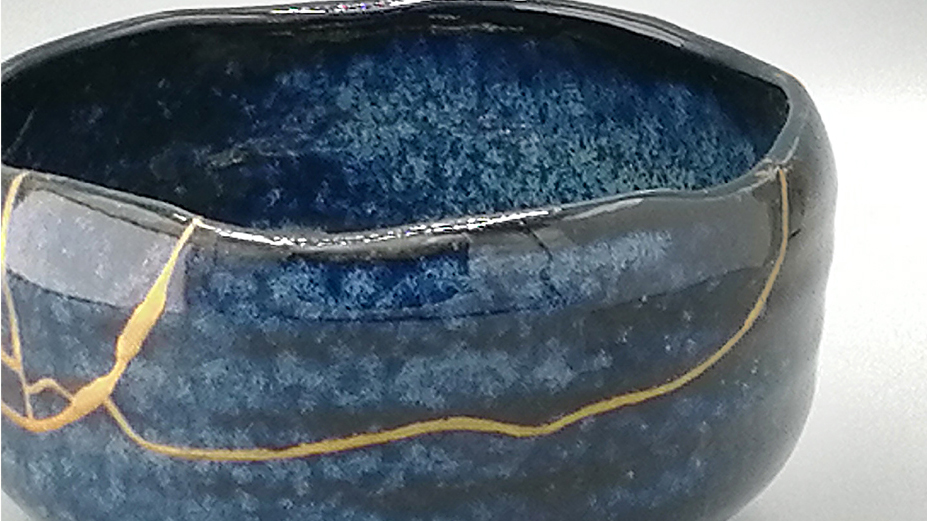Kintsugi, a word made up of 金 kin (gold) and 継ぎ tsugi (connect, rejoin), is an ancient Japanese ceramic restoration technique that uses urushi lacquer to weld together fragments of a broken object and gold dust to highlight the broken lines. Instead of masking or hiding fractures, kintsugi embellishes them as if they were a new distinguishing feature of the object.
Since ancient times, the Japanese have regarded the cracks and chips in a vase as a feature of the vase itself and savored them as scenery (keishiki). An aesthetic sense born and nurtured in the culture of the tea ceremony and Zen Buddhism and closely related to the concepts of wabi and sabi, which celebrate elements of imperfection, simplicity, the passage of time, and impermanence.
With its symbolism firmly hinging on resilience, kintsugi has also found great popularity in the West. Certainly because of the metaphor of fractures resembling wounds of the soul that, if welcomed and valued, cease to be a reason for affliction and transform into elements of strength.
But far from the idea, popular today, that chemical glue and goldporin are enough to define “kintsugi” as a repair carried out in a few hours, the technique that the Japanese have handed down for centuries makes exclusive use of natural materials, such as rice flour and tonoko and jinoko clay powders, but especially urushi lacquer, a plant resin extracted from the bark of the plant Rhus Verniciflua, which requires long drying times to cure.
The course, consisting of 4 lectures, offers an authentic approach to approaching the traditional technique: in addition to the practical section that will familiarize students with the use of urushi lacquer, the course is enriched with a theoretical part, in which they will learn about the historical origins of kintsugi and the culture of urushi lacquer (urushi-bunka).
Cost: 300 euros
Reservations: 0546697311, info@micfaenza.org
Course program in 4 lectures (tot 10 hours)
Lecture I – January 13, 2024, 3 – 5 p.m.
▪ Theory > urushi lacquer: properties and uses.
▪ Study of materials in use.
▪ Sanding and pretreatment of breaks with sute-urushi,
▪ Bonding of parts with mugi-urushi
▪ Preparation of a container (wall) in which to place the pottery for drying;
Lecture II – January 27, 2024, 3 – 5 p.m.
▪ Theory > urushi lacquer in art, maki-e
▪ Cleaning up excess glue
▪ Grouting and reconstruction of small chips with sabi-urushi
Lecture III – February 10, 2024, 3 – 5 p.m.
▪ Theory > the tea ceremony and wabi-sabi aesthetics.
▪ Sanding of the putty (sabi-togi).
▪ First brush application of a layer of kuro-urushi lacquer
Lecture IV – February 24, 2024, 3 – 5 p.m.
▪ Theory > kirei-sabi and the origins of kintsugi
▪ Filtering and second brush application of a layer of bengara-urushi lacquer ▪ Dusting of golden powder (kin-maki).
Notes
A minimum of 4 lessons (spaced at least a week apart) are required to complete the restoration of an object, as urushi lacquer needs a drying time of 3 or more days after each processing step.
A pottery will be provided at the course for repair that will remain with the participant. Those who wish may bring an object (a small bowl or plate) from home to be broken or already broken, as long as it is in a maximum of 3 fragments.
The materials needed to conduct the course, all sourced from Japan, will be provided at class and the cost obviously included in the price, with the exception of pure gold powder (replaced during the course by brass gold powder) for sale upon request.
Recommendations
Urushi lacquer contains a stinging component that can cause skin irritation; the use of latex gloves and wearing a long-sleeved shirt is recommended.
To dry the lacquer properly, the ceramic should be stored in a container called a wall at controlled temperature and humidity. The participant will be taught how to make a simple wall at home.
Lecturer
The course is led by Irene Carlino, a nipponist and scholar who is passionate about traditional Japanese craft techniques. Irene has lived and worked in Japan for many years holding important managerial positions in Italian luxury companies. He began the practice of Kintsugi in 2018 during his stay in Tokyo and continued the study always and exclusively with Japanese teachers. Today he follows Master Kiyokawa Hiroki from whom he learned advanced kintsugi restoration techniques.



